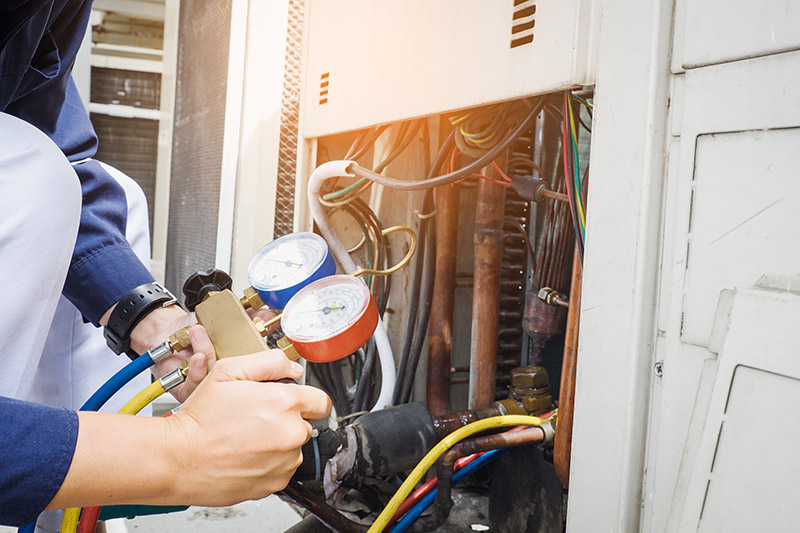Air conditioning keeps things cool by removing excess humidity from your inside air. It also “conditions” air with the help of refrigerant that, in turn, gets some assistance from AC components that include compressors and evaporators. We’ll go over the basics of how refrigerants work in air conditioning systems in greater detail below.
How AC Refrigerant Works
AC refrigerant runs through copper coils. As it does, heat from indoor air is absorbed and transitions from a low-pressure gas to a higher pressure liquid. Next, the refrigerant makes its way outside. The fan on the outside unit blows hot air over coils inside the unit, and it’s then exhausted into the air outside of your home.
At this point, the refrigerant cools again and becomes a low-pressure gas once more. Finally, an interior fan blows air over another set of coils. This is what allows cooler, “conditioned” air to be sent throughout your inside living spaces. The cycle repeats as long as your air conditioning system is operating.
The Different Types of AC Refrigerant
Up until 1994, chlorofluorocarbons, or CFCs, were commonly used in air conditioners. These refrigerants, which included R12, were discontinued because of greenhouse gas concerns. Since then, two other types of refrigerant have been primarily used for air conditioning:
Hydrochlorofluorocarbons
R22 and other CFCs are considered less risky in terms of potential environmental issues. However, the Environmental Protection Agency mandated a phase-out of CFCs in 2010, which was completed by 2020.
Hydrofluorocarbons
These are “greener” refrigerants with no chlorine included in the mixture at all. Additionally, AC systems that use these newer refrigerants tend to be more efficient, and they often improve overall comfort and air quality. HFCs include R410A and R134.
Air conditioning keeps things cool by removing excess humidity from your inside air. It also “conditions” air with the help of refrigerant that, in turn, gets some assistance from AC components that include compressors and evaporators. We’ll go over the basics of how refrigerants work in air conditioning systems in greater detail below.
How AC Refrigerant Works
AC refrigerant runs through copper coils. As it does, heat from indoor air is absorbed and transitions from a low-pressure gas to a higher pressure liquid. Next, the refrigerant makes its way outside. The fan on the outside unit blows hot air over coils inside the unit, and it’s then exhausted into the air outside of your home.
At this point, the refrigerant cools again and becomes a low-pressure gas once more. Finally, an interior fan blows air over another set of coils. This is what allows cooler, “conditioned” air to be sent throughout your inside living spaces. The cycle repeats as long as your air conditioning system is operating.
The Different Types of AC Refrigerant
Up until 1994, chlorofluorocarbons, or CFCs, were commonly used in air conditioners. These refrigerants, which included R12, were discontinued because of greenhouse gas concerns. Since then, two other types of refrigerant have been primarily used for air conditioning:
Hydrochlorofluorocarbons
R22 and other CFCs are considered less risky in terms of potential environmental issues. However, the Environmental Protection Agency mandated a phase-out of CFCs in 2010, which was completed by 2020.
Hydrofluorocarbons
These are “greener” refrigerants with no chlorine included in the mixture at all. Additionally, AC systems that use these newer refrigerants tend to be more efficient, and they often improve overall comfort and air quality. HFCs include R410A and R134.
When to Consider a Refrigerant Upgrade
There is no requirement for homeowners to immediately replace air conditioning systems that still use R22 refrigerant. But if you have a refrigerant leak, it could be challenging to find R22 since it’s no longer used in newer cooling systems.
Plus, systems designed to run on R22 cannot function correctly with the newer refrigerants like R4010A. Therefore, if you have an older cooling system and a refrigerant issue, it’s worth considering an upgrade to a newer model compatible with R4010A. You’ll also benefit from added system efficiency and indoor comfort by doing so.
Call Us Today
Refrigerant levels should remain fairly consistent. However, they can drop if there’s a leak, even if you’re not yet aware of it. If you see signs of poor AC performance that may indicate a leak, contact the local experts from Romano Bros. Heating & Air to determine what’s going on with your air conditioning or cooling system. We’re also at your service if it’s time for an AC upgrade.
Call our air conditioning and comfort pros today for fast, affordable, top-quality service and results.


